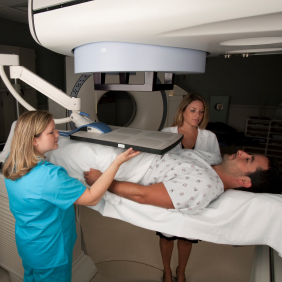Long-Term Results Confirm Value of RT for Prostate Cancer Survival
Adding a treatment course of local radiotherapy to hormonal treatment in men with locally advanced or high-risk prostate cancer more than halved the 10-year and 15-year prostate-cancer–specific mortality.
Adding local radiotherapy to hormonal treatment halved the 10-year and 15-year prostate-cancer–specific mortality.

Adding a treatment course of local radiotherapy to hormonal treatment in men with locally advanced or high-risk prostate cancer more than halved the 10-year and 15-year prostate-cancer–specific mortality compared to treatment with anti-androgens alone, according to updated results from the Scandinavian Prostate Cancer Group VII study.
“In these patients the combination of radiotherapy and hormones may be considered as a standard curative treatment option and patients should be informed about this,” said Sophie Dorothea FossÃ¥, MD, a professor in the department of oncology at Oslo University Hospital in Norway, at the 2014 ASCO Genitourinary Cancers Symposium.
This updated data showed that at 10 years, cumulative prostate-cancer–specific mortality was 8.3% in patients assigned combination treatment compared with 18.9% in the anti-androgen alone arm; at 15 years, it was 12.4% compared with 30.7% in the anti-androgen alone arm.
In 2009, the Scandinavian Prostate Cancer Group presented results from this study showing a 12% reduction of prostate-cancer–specific mortality in patients on combined treatment after a median follow-up of 7.6 years. In these updated results, FossÃ¥ provided the 10-year and 15-year prostate-cancer–specific survival after a median observation of 10.7 years.
Between 1996 and 2002, Fosså and colleagues enrolled 875 patients aged younger than 75 years from Norway, Sweden, and Denmark. All patients received 3 months of total androgen blockade and were then randomly assigned to endocrine treatment with the anti-androgen flutamide alone (n = 439) or combined with radiotherapy (n = 436).
Looking at the final study results, patients assigned to combined treatment had an almost 11% reduction in absolute risk for prostate-cancer–specific mortality at 10 years, and an 18% reduction at 15 years. Specifically, there were 118 prostate-cancer–specific deaths in the anti-androgen alone arm compared with 45 in the combination arm.
“Of course the difference was less for the overall mortality though still significant,” FossÃ¥ said. “As we know many patients die of other disease other than prostate cancer.”
In addition to the significant reduction in prostate-cancer–specific mortality seen with the combined treatment, overall mortality was also reduced in the combination arm at both 10 years (35.3% vs. 26.4%) and 15 years (56.7% vs. 43.4%).
Patients experienced long-term adverse effects concerning the urinary, bowel, and sexual dimensions, Fosså said. The events were limitedly more pronounced in the combination arm than in the endocrine treatment alone arm. However, after 4 years, the researchers found no effect of the combination treatment on global quality of life.
In a discussion of the results, Andrew J. Stephenson, MD, director of urologic oncology at Glickman Urological and Kidney Institute at the Cleveland Clinic, said that the trial could be criticized somewhat as low-dose flutamide is not considered the current standard of care in terms of current androgen deprivation therapy.
“Nevertheless we have from a Canadian trial evidence that in combination with standard hormone therapy by contemporary standards external beam radiation therapy significant improves all important, clinically significant outcomes with respect to progressive disease.”
Newsletter
Stay up to date on recent advances in the multidisciplinary approach to cancer.
Navigating Treatment Intensification in Metastatic Hormone-Sensitive Prostate Cancer
A patient case of a 50-year-old man with hormone-sensitive prostate cancer sparked a debate among oncologists regarding the best course of action.